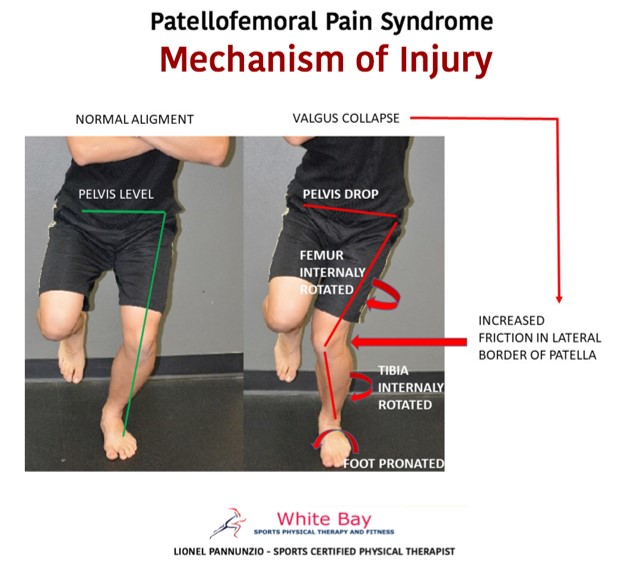
05 May Patellofemoral Pain Syndrome Explained – Part I
This Post has been created and reviewed by Lionel Pannunzio (Physical Therapist and Board-Certified Sports Specialist at White Bay Physical Therapy)
Runner’s knee is the common term used to describe any one of several conditions that cause pain around the kneecap, also known as the patella.
The two most common condition include
- Anterior knee pain syndrome also known as Patellofemoral Pain Syndrome (PFPS), patellofemoral malalignment, chondromalcia Patella
- Illiotibial Band Syndrome ( ITBS)
Today I will share with you the latest research about Patellofemoral Pain Syndrome (PFPS) and we will talk about ITBS in the next couple of weeks.
Patellofemoral pain syndrome (PFPS) refers to pain at the front of the knee, in and around the kneecap. (The kneecap, or patella, is the triangle-shaped bone at the front of the knee joint.) Pain occurs when friction is created between the undersurface of the kneecap and the thigh bone (femur). The pain also is usually accompanied by tenderness along the edges of the kneecap.
Incidence
PFPS is one of the most common injury in Runners. Definitely is the most common knee injury in this athletic population. It accounts for % of total of runner’s injuries.
Causes of PFPS
Current research indicates that PFPS is an “overuse syndrome,” which means that it may result from repetitive or excessive use of the knee.
Other contributing factors may include:
– Weakness, tightness, or stiffness in the muscles around the knee and hip
– An abnormality in the way the lower leg lines up with the hip, knee, and foot
– Improper tracking of the kneecap
These conditions can interfere with the ability of the kneecap to glide smoothly on the femur (the bone that connects the knee to the thigh) in the femoral groove (situated along the thigh bone) during movement. The friction between the undersurface of the kneecap and the femur causes the pain and irritation commonly seen in PFPS.
PFPS often occurs in runners players who have suddenly increased their level of activity (mileage) too fast.
How Does it Feel?
Pain while bending or straightening the knee on bed
Pain when walking up or down stairs or hills
Pain when walking on uneven surfaces
Pain that increases with activity and improves with rest
Pain that develops after sitting for long periods of time with the knee bent
A “crack” or “pop” when bending or straightening the knee

A key factor in PFPS development is dynamic valgus of the lower extremity, which leads to lateral patellar maltracking and patellofemoral pain. Dynamic Valgus happens during normal single leg activities. With poor mechanical control of the Pelvis and Lower Extremity the knee will go into an Excessive Dynamic Valgus . In this case the Patella will come under excessive stress. All these deviations are even more noticeable when striking on the foot during running. Excessive Dynamic Valgus.
- Pelvis Drop
- Femur rotates internally
- Tibia also rotates internally
- Foot collapses inwards (excessive pronation)
During excessive dynamic Valgus Patella has no other option than follow the femur / tibia / foot deviations and it will track laterally creating more friction in the lateral side with the typical lateral-patella pain.

Overuse: Too much load , too Fast as the cause of PFPS
Overuse, in this case means an overload to a dysfunctional Patellofemoral joint.
Think about building friction over time:
- More training (rapid increase in mileage)
- More intensity of the training (hill workouts , repetitive jumps)
- More frequent races
- Returning to run after a long period of inactivity
Too much Load, applied too fast…
In these situations, the kneecap will became irritated first and more painful over time. Runners will continue training at the beginning because pain usually goes away with warm up. As the condition progresses and the root of the problem is not solved , pain will continue increasing in intensity and it will not disappear with warm up, continuing getting worse till one day the athlete can not compete anymore
We as therapists will look for recent alterations in sporting activities. Any changes in the frequency, duration and intensity of training should be investigated in detail.
The training program also should be appraised for errors, including increasing the exercise intensity too rapidly, inadequate recovery time and extreme hill workouts.
It must be considered that PFP may present as an acute re-exacerbation of the chronic condition.
===>> Continue to Part II (Treatment)
Do you have any questions? Drop a note, we’d love to hear from you.
Sign Up and ask the Therapist.
Lionel Pannunzio is a Physical Therapist and Board-Certified Sports Specialist, owner of White Bay Physical Therapy.
He has been helping runners for more than 20 years
“Keeping Athletes in the game”
With offices located at 17180 Royal Palm Blvd – Weston – Florida – 33326
You can reach him at 754-244-2561
Visit his website: www.wbsphysicaltherapy.com
lionel@wbsphysicaltherapy.com

Sorry, the comment form is closed at this time.